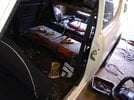Here's what I don't understand: if this is a guaranteed result of the Gruber method, how come there aren't people out on forums saying "Gruber method doesn't work" or whatever? Who are all these people paying $5k for a car that bricks itself after a week? Might you be underestimating the BMS's ability to handle severely out of balance packs?
Firstly, I think the number of people actually paying them to do this "repair" very likely is zero or close to zero. It wouldn't surprise me if this is just a bait and switch tactic, either, because there are virtually no packs that have the issue they describe where you'd even consider snipping a cell fuse anyway. Any random Joe TeslaOwner coming to them with a battery issue is not likely to have an issue supposedly resolvable by snipping a cell fuse. I've had at least three customers come to me for battery replacements after speaking with them. Not my place to go into the details, but suffice it to say two of those customers more happily shipped their vehicles all the way from the west coast for us to work on them vs going with what was offered elsewhere. (Other one was local-ish.)
Secondly, at the risk of sounding arrogant, I know just about everything there is to know about the Tesla S/X BMS. Guarantee I know more than anyone outside of Tesla, and probably more than some people who have even worked on the BMS at Tesla. I've worked on this for over half a decade now. I know exactly what its capable of, how the code works, and what its not capable of. Let's put it this way, I've completely designed from scratch a drop-in replacement for the Tesla BMS that lets me run a Tesla vehicle off of any battery I want. See my earlier posts about running a Tesla Model S off of a Chevy Volt pack in the trunk.
Lastly, and perhaps more damning than any of the above: I've tested this. We've tried all sorts of ways of repairing packs with issues before, and the "cut a cell fuse" method does not work. Granted, that's not something I intentionally did because, well... I have a brain. Instead I had a pack with accidental physical damage to a single cell fuse on a module from a botched BMB replacement repair (attempted by a third party). In an attempt to get this car up and running, I manually balanced the entire pack to within 3mV and got the thing running again. I tested every module and confirmed the only issue was the one missing cell fuse. Everything worked fine...... for about 5 charge cycles. Then the BMS threw the initial (hidden) SoC imbalance code. After about 2 weeks of normal use, the car was not drivable at all and had to be towed back.
We also tested other "simple" fixes, such as replacing an individual module entirely with one that had as close as possible of a capacity to the rest of the pack. We tried this several times. Even when matched as best as we could (which I honestly thought was super close, since we had a pack built in the same month from a similar mileage donor car and pretty close measure capacity), we
still couldn't satisfy the BMS for an extended period. This was our best effort, and the car worked normally for about a month before the BMS gave up due to the persistent imbalance. Logs shows the BMS was concerned after only a few days of use, and eventually threw in the towel after about a month of use (only about 1500 miles).
Suffice it to say, outside of Tesla no one has as much knowledge and experience with these batteries, BMS, etc than I and my company do. We've processed hundreds of Model S/X vehicles, and thousands of battery modules. We don't have to make flashy professionally edited YouTube videos about everything we do in order to grab customers. So far, 100% of our business is word of mouth or otherwise organic search stuff... which is impressive to me considering how objectively terrible our website is at the moment. But, function over form, for sure... I mean, I have some YouTube videos up, but lol.
Anyway... to summarize, the Tesla BMS was not designed to handle the complete loss of one or more cells. It was designed to detect this so the pack can be replaced. It's just basic math. 100mA bleed vs a ~3200 mAh delta (lost cell) in a ~250,000 mAh system is just not viable. Even the worst "natural" imbalances I've seen are on the order of few hundred mAh... not thousands.



